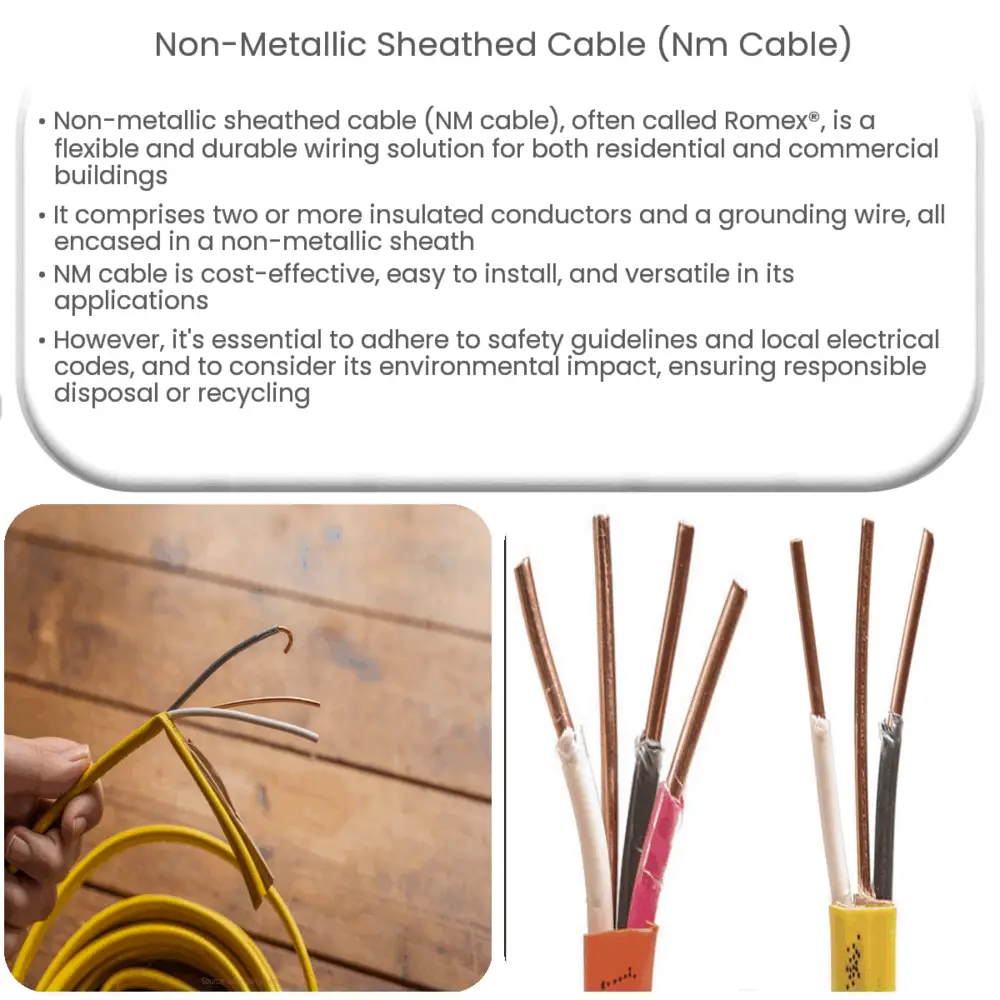Non-metallic sheathed cable (NM cable) is a flexible, durable wiring solution used in residential and commercial buildings, offering easy installation and cost-effectiveness.

Non-Metallic Sheathed Cable (NM Cable): An Overview
Introduction
Non-metallic sheathed cable (NM cable), commonly referred to as Romex®, is a popular and versatile wiring solution used in residential and commercial buildings. It is a type of electrical cable encased in a non-metallic, plastic sheath that is both flexible and durable. This article provides a comprehensive look at the features, applications, and advantages of NM cable, along with important safety considerations.
Composition and Features
NM cable typically consists of two or more insulated conductors and a bare grounding wire, all wrapped within a flexible, non-metallic sheath. The conductors are usually made of copper or aluminum and are color-coded to indicate their function. The sheath is generally made of polyvinyl chloride (PVC) or thermoplastic high heat-resistant nylon-coated (THHN) material, providing protection and insulation for the conductors.
There are several types of NM cable available, designed for different purposes and applications. These include:
- NM-B: This is the most common type of NM cable, typically used for indoor residential and commercial wiring. It is rated for a maximum voltage of 600V and temperatures up to 90°C.
- NMC: This type of cable is similar to NM-B but has an additional moisture-resistant outer covering, making it suitable for damp or corrosive environments.
- UF-B: Underground Feeder cable (UF-B) is designed for direct burial applications and has a solid, moisture-resistant sheath. It is suitable for both indoor and outdoor use and can be used in wet or corrosive environments.
Applications and Advantages
NM cable is widely used in residential, commercial, and light industrial settings for wiring electrical systems, such as lighting circuits, receptacle circuits, and small-appliance circuits. It is also suitable for powering devices like air conditioners, furnaces, and water heaters. Some of the key advantages of NM cable include:
- Cost-effective: NM cable is relatively inexpensive compared to other wiring methods like metal conduit, making it a popular choice for many applications.
- Easy installation: The flexible nature of NM cable makes it easy to install and route through walls, ceilings, and floor cavities without the need for conduit or other protective enclosures.
- Versatility: Available in a variety of conductor sizes and configurations, NM cable can be tailored to the specific needs of a project or application.
- Insulation and protection: The non-metallic sheath provides excellent insulation and protection for the conductors, reducing the risk of electrical fires and ensuring a safe installation.
Safety Considerations and Code Compliance
While NM cable offers numerous advantages, it is essential to follow safety guidelines and comply with local electrical codes when installing and using this type of wiring. Some key safety considerations include:
- Indoor use: Unless specifically rated for outdoor use or direct burial (such as UF-B cable), NM cable should be installed indoors and protected from moisture, corrosive materials, and direct sunlight.
- Proper cable selection: Choose the appropriate type and size of NM cable for the intended application, taking into account factors such as voltage, current, and temperature ratings.
- Secure installation: Secure NM cable to framing members using cable staples, straps, or hangers at regular intervals to prevent damage from movement or abrasion.
- Avoid overcrowding: Do not exceed the maximum allowable number of cables in a single junction box or conduit to reduce the risk of overheating and electrical fires.
- Grounding: Ensure that the bare grounding wire is properly connected to the grounding system of the building to provide a safe path for fault current and reduce the risk of shock.
Always consult local electrical codes and engage a licensed electrician for advice and installation to ensure the safety and compliance of your NM cable wiring system.
Environmental and Recycling Considerations
As with any electrical wiring solution, there are environmental factors to consider when using NM cable. The PVC sheath used in most NM cables is not biodegradable and can release toxic substances when burned. It is crucial to dispose of NM cable responsibly and according to local waste management regulations.
Many recycling centers accept NM cable for recycling, separating the copper, aluminum, and plastic components for reuse in new products. Recycling NM cable not only helps to conserve valuable resources but also reduces the environmental impact of manufacturing new wiring materials.
Conclusion
Non-metallic sheathed cable (NM cable) is a versatile, cost-effective, and easy-to-install wiring solution for various residential and commercial applications. By understanding its features, applications, advantages, and safety considerations, users can make informed decisions about when and how to use NM cable in their electrical projects. Always consult local electrical codes and hire a licensed electrician to ensure the safe and compliant installation of NM cable wiring systems.

